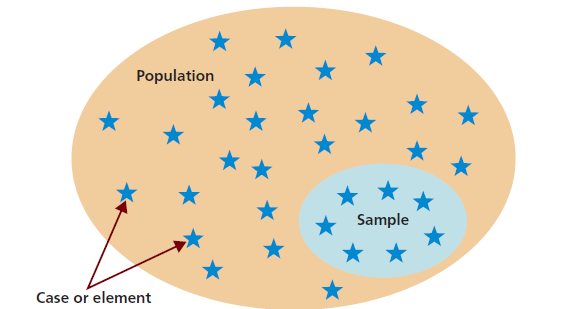
Sampling can be explained as a specific principle used to select members of population to be included in the study. It has been rightly noted that “because many populations of interest are too large to work with directly, techniques of statistical sampling have been devised to obtain samples taken from larger populations.”[1]. In other words, due to the large size of target population, researchers have no choice but to study the a number of cases of elements within the population to represent the population and to reach conclusions about the population (see Figure 1 below). Figure 1. Population, sample and individual cases[2] Brown (2006) summarizes the advantages of sampling in the following points[3]: a) Makes the research of any type and size manageable; b) Significantly saves the costs of the research; c) Results in more accurate research findings; d) Provides an opportunity to process the information in a more efficient way; e) Accelerates the speed of primary data collection. The Process of Sampling in Primary Data Collection The process of sampling in primary data collection involves the following stages: 1. Defining target population. Target population represent specific segment within wider population that are best positioned to serve as a primary data source for the research. For example, for a dissertation entitled ‘Impact of social networking sites on time management practices amongst university students in the UK” target population would consist of individuals residing in the UK. 2. Choosing sampling frame. Sampling frame can be explained as a list of people within the target population who can contribute to the research. For a sample dissertation named above, sampling frame would be an extensive list of UK university students. 3. Determining sampling size. This is the number of individuals from the sampling frame who will participate in the primary data collection process. The following observations…
Introduction Due to the forces of globalisation, increasing significance of internet in everyday life and a range of other factors the nature of the workforce is going through changes. In order to survive in today’s highly competitive marketplace companies have to deal with changes in their workforce efficiently. Specifically, companies need to devise initiatives and programs aimed to deal with the issues of the ageing the population in many developed countries the percentage of which represent their workforce, as well as their need to implement practices that eliminate the possibility of diversity in the workforce becoming a major issue within an organisation. Moreover, because of the changing patterns of employment including working from home and job sharing, companies are left with no choice but to accommodate workforce who prefer these new working patterns as well. This paper aims to analyse at what extent Apple Corporation, US multinational company producing consumer electronics, computer software and personal computers is fulfilling its need to adapt to changes in its workforce. Specifically, the paper will analyse four major changes in workforce which are ageing workforce, diversity of the workforce, flexibility of the workforce, and changes in training and development needs. Ageing Workforce Ageing workforce is one of the major problems US, European counties, Russia and a range of other countries face. Boone and Kurtz (2009) inform that by 2030 the number of Americans above the age of 65 will double and reach 72 million people, representing almost 20 per cent of US population. People who were born in the period of ‘baby boom’ after the second world war are approaching their retirement age with no enough young people to replace them in their job positions and this fact is creating problems in many levels. Management at Apple corporation totally comprehend the issues related to…
By John Dudovskiy
Category: HRM
Dutka (1995) informs that DAGMAR model stands for ‘Defining Advertising Goals for Measured Advertising Results’ and is one of the most approaches to the advertising planning process. According to DAGMAR model a potential customer goes through four steps before making a purchase: 1. Awareness 2. Comprehension 3. Conviction 4. Action References Dutka, S, 1995, “Dagmar: Defining Advertising Goals for Measured Advertising”, NTC Business Books
This text sets out the terms under which research-methodology.net (Portal), and its content, search facilities, directory services, email, and other internet services provided by Portal can be accessed and used by website visitors (Users). By accessing the Portal, Users agree to be bound by these terms and conditions. The following points represent the terms of using the Portal: Users agree that they will only use Portal in a manner that is consistent with these user conditions and in such a way as to ensure compliance with all applicable laws and regulations. Portal provides links to other web sites or resources. Portal does not accept responsibility for these web sites or resources; neither can it be deemed to have endorsed their content, products or services merely because they are accessible through the Portal. Users agree that the material and content contained within or provided by Portal is for personal use only and may not be distributed commercially without written permission Reliance on information, material, advice, or other linked or recommended resources, offered from Portal, is at Users’ sole risk, and Portal assumes no responsibility for any errors, omissions, or damages arising When using materials provided by Portal, Users must decide if the usage is ‘fair use’ within their local law relating to copyright The free provision of materials on Portal does not imply that the works can be exploited for profit without seeking permission from respective owners of original concepts, theories and other intellectual property Portal reserves the right to change the terms and conditions of this agreement at any time. Changes will be effective upon their display on the user agreement page of this web site. If you have any questions or concerns regarding Terms and Conditions or any other aspect of the website please feel free to contact us.
research-methodology.net is a portal that offers knowledge and resources for conducting business studies. The materials published at research-methodology.net are designed to support and inspire professionals and students at all levels to conduct business-related researches. research-methodology.net requires no registration to use its resources Please read our Terms and Conditions

Research can be defined as “an activity that involves finding out, in a more or less systematic way, things you did not know” (Walliman and Walliman, 2011, p.7). “Methodology is the philosophical framework within which the research is conducted or the foundation upon which the research is based” (Brown, 2006). Research Methodology chapter of a research describes research methods, approaches and designs in detail highlighting those used throughout the study, justifying my choice through describing advantages and disadvantages of each approach and design taking into account their practical applicability to our research. O’Leary (2004, p.85) describes methodology as the framework which is associated with a particular set of paradigmatic assumptions that we will use to conduct our research. Allan and Randy (2005) insist that when conducting a research methodology should meet the following two criteria: Firstly, the methodology should be the most appropriate to achieve objectives of the research. Secondly, it should be made possible to replicate the methodology used in other researches of the same nature The differences between objectivist and subjectivist dimensions are presented by Cohen et al (2007) as taken from Greenfield (1975) in the following manner: Dimensions of comparison Objectivist Subjectivist Philosophical basis Realism – the world exists and can be studied as it is Idealism – the world exists, but is studied differently by different people Role of social science Exploring universal laws of the society and the behaviour of people within it Exploring how the world is interpreted by different people Basic units of social reality Society or organisation(s) Individuals Comprehension methods Studying the type and nature of various relationships that allow the collectivity to exist Studying subjective meanings that individuals impose upon their actions Theory A rational construction that has been proposed by researchers in order to explain the human behaviour Sets of…
